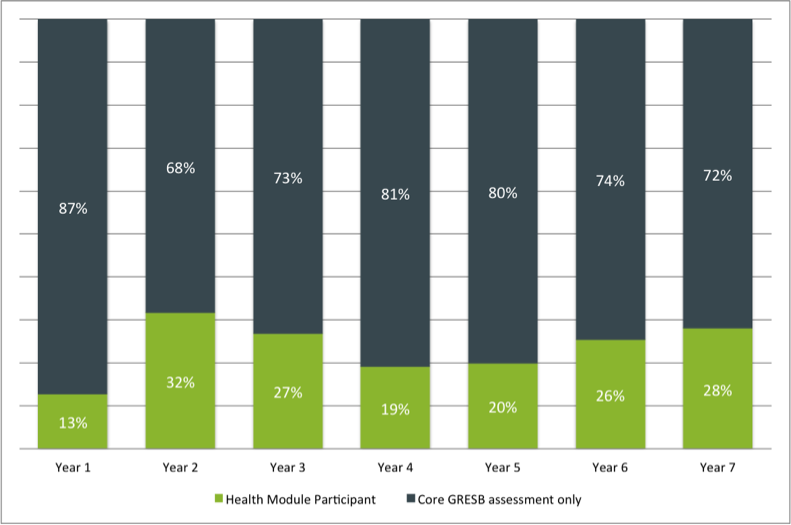Code Green Solutions


At Greenbuild, GRESB released the results from their first ever Health & Well-being Module to provide insight into how property companies and funds around the world are promoting health and well-being. Real estate companies are positioned to promote health and well-being through both internal and external mechanisms. Internal health promotion refers to policies and actions by companies as employers focused directly on their own workforce. External health promotion refers to intentional actions taken by real estate companies and funds to improve the health and well-being of their tenants, customers and the communities surrounding their real estate assets. External health promotion arguably represents the largest unrealized opportunity for value creation due to the increasing demand for real estate assets that consider health and well-being impacts from tenants and building owners. The GRESB Health and Well-being Module and component indicators are organized to identify and promote high performance in both internal and external domains.
This week, a white paper from the Green Health Partnership, an initiative of the University Virginia School of Medicine and the U.S. Green Building Council with funding from the Robert Wood Johnson Foundation, provides a deeper look at data gathered by the Module. A couple of new insights have emerged:
1. The type of leadership for health seems to impact the type of health promotion efforts that real estate entities pursue.
Most real estate companies and funds (60%) indicated that human resources professionals lead the entity’s health promotion efforts while a smaller portion of participants (32%) indicated that their sustainability leader was serving a dual role inclusive of health promotion. Participants with leaders from human resources were more likely to prioritize internal and programmatic health promotion efforts in comparison to participants with leaders focused on sustainability, who were more likely to prioritize external and design oriented health promotion efforts. As one example, 70% of entities for whom the senior sustainability leader is an HR professional implement internal programmatic health strategies, while only 50% implement internal design and operations strategies. Bridging conversations between HR and sustainability professionals may provide an opportunity to increase the impact of health promotion efforts.
2. The GRESB Health & Well-being Module attracted participants with varying levels of sustainability performance.
Real estate companies and funds that chose to participate in the Health & Well-being Module had, on average, higher scores on the GRESB Assessment as compared to those funds that did not participate (67.6 to 58). However, health module participants demonstrated a wide range of performance on the GRESB Assessment. While the greatest proportion of health module participants (40%) were in the top quartile of GRESB performance, a full 36% of scores fell in the bottom 2 quartiles. Interestingly, module participants had a similar level of prior participation in GRESB as compared to GRESB Assessment participants. In each case, half (50%) of respondents had participated in the core assessment for 3 or fewer years, with the other half (50%) having participated for 4 or more years. This supports the assertion that health presents an emerging and valuable market, and that interest is not limited to longstanding market leaders.

Percent of responding entities choosing to participate in the health module by years of participation in GRESB.
3. Drivers for health considerations within the real estate sector extend beyond the reduction of financial risk associated with healthcare costs.
Data from the Module shows that almost all companies face financial risks from health and well-being; however, risks are not spread evenly across the industry. Unsurprisingly, funds in the United States report the highest level of exposure to financial risk where the employer bears a significant financial burden related to employee health insurance. However, the data show that exposure to healthcare costs is not necessarily associated with action to promote health and well-being. In fact, European and Australian firms reported much lower exposure to cost, but are still taking action to promote health and well-being both internally and externally. On the whole, nearly 90% of entities not exposed to financial risk are still taking action to promote the health and well-being of their employees, with 60% of these entities also taking action to promote the health and well-being of their tenants and customers. This suggests that these real estate companies and funds see value in health considerations that extends beyond traditional cost reduction strategies.
Aside from the more detailed conclusions explored in this new white paper, the greatest discovery of the GRESB Health & Well-being Module is that real estate companies and funds are increasingly engaging in efforts to promote health and well-being, both for their own and employees and for their tenants and customers. Almost as many real estate companies and funds chose to participate in the Module as participated in the inaugural GRESB Assessment in 2009 (174 vs. 198 entities). Over the past 6 years, participation in the GRESB Assessment has more than tripled with 759 entities participating this year. If health and well-being considerations follow a similar growth pattern as sustainability, the next 5 years present a tremendous opportunity for promoting public health through real estate practice.
Access the white paper in its entirety here: http://www.usgbc.org/resources/state-health-considerations-commercial-real-estate-sector-initial-look-results-gresb-healt